Summary of St Ives School
The St Ives School was a name given to a cadre of artists who lived and worked in the picturesque Cornish coastal town that came to international prominence after World War Two. Having settled in the area during the war years, Ben Nicholson, Barbara Hepworth, and the Russian émigré Naum Gabo, transformed St Ives into a hub for a new British avant-garde. They attracted many younger abstract artists to the area, and though their formal approaches fluctuated between semi and pure abstraction, members of the St Ives School took their inspiration from the unique West Cornwall landscape, using its shapes, natural surroundings and colors to inspire their individual visions. Once Abstract art had been overtaken by Pop Art in the 1960s, the St Ives School was winding down but its proud legacy is kept alive today through the Barbara Hepworth Museum and Sculptural Gardens, opened in her previous studio in 1980, and through the Tate St Ives gallery which opened in 1993 and takes pride of place on its seafront.
Key Ideas & Accomplishments
- The St Ives School (though in point of fact it was never a formal School) owes its inception to one Alfred Willis, an elderly Cornish mariner. Wallis's unrefined, almost child-like, seascapes, which he painted onto raw materials such as cardboard and driftwood, provided the stimulation for a community of artist who were inspired by the raw honesty of his painting and a rare authenticity that captured Wallis's innate affinity with his natural environment.
- Hepworth and Nicholson, arrived in St Ives with the goal of initiating the next phase of modernism. Calling on the principals of Constructivism, Cubism, and De Stijl, they achieved their goal (and inspired others to follow) by harnessing the unique shapes, patterns and lighting conditions of England's south-western coastline.
- Hepworth's abstract sculptures were characterized by flowing, circular forms and she developed a deep connection with St Ives, taking fresh inspiration (unlike her fellow sculptor Gabo, who focused all his energies on purely formal matters) from the natural forms of the Cornish landscape including seashells, crashing waves, and ragged rock formations.
- Nicholson's work explored the dividing line between realism and abstraction. His still lifes and landscapes took on the influence of Cubism and De Stijl while capturing something of the makeshift quality of Wallis's pictorial work. Nicholson would have a profound influence on the younger St Ives painters such as Patrick Heron and Wilhelmina Barns-Graham.
- Though works could be realist - Heron, for instance, produced several views of St Ives using heightened colors and bold lines - generally speaking the School moved more and more towards abstraction. Heron took on the influence of Abstract Expressionists, and particularly Mark Rothko's saturated passages of color, which he employed to condense the essence of the coastal town onto a two-dimensional surface. Painters such as Peter Lanyon, on the other hand, used a wide range of colors to capture the energy of the Cornish coast.
Overview of St Ives School
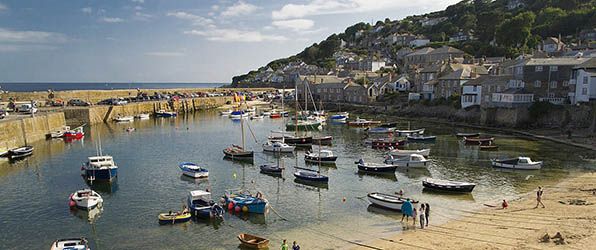
For the sculptor Barbara Hepworth, it was only when she was "embraced by the land and seascape" of St Ives that she gained "practical and passionate" inspiration for works she modelled "with an exactitude of form that those without sight can hold and realize".
Artworks and Artists of St Ives School
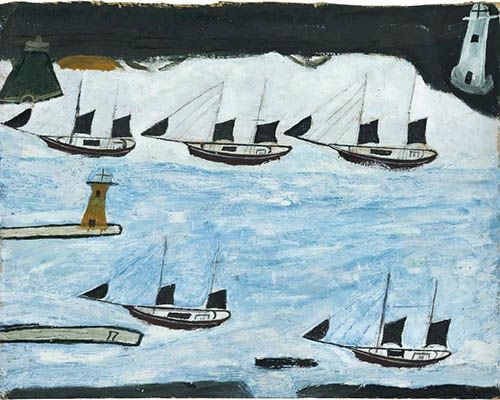
Five Ships, Mounts Bay
Alfred Wallis captures the turbulent energy of the Cornish sea in this painting, with frothy passages of paint that seem to flicker in the light. Tiny fishing vessels drawn with black, spidery lines seem fragile and insignificant in the face of the sea's unstoppable energy. Scattered lighthouses suggest a glimmer of human life, but they are painted with loose, watery paint as if they might collapse at any moment.
Having spent much of his early adult life working as a fisherman in the Cornish coastlines, Wallis knew the mariner's life inside-out, and his unsophisticated paintings capture the perilous nature of life at sea with huge, dangerous waves and fragile boats caught in their majesty. Wallis came to painting later in life (at the age of 70) and was entirely self-taught. This gave his paintings a naïve folk-art look, characterized by broad areas of flat color and thick black contours, painted onto rough scraps of wood or cardboard. Wallis made this painting in 1928, the same year that he was visited and "discovered" by the London-based artists Ben Nicholson and Christopher "Kit" Wood. Nicholson was particularly enamoured with the simple, rugged and untutored style of Wallis's art and he helped launch the Cornishman's career within his lively circle of artistic friends in London. Wallis's innate, almost spiritual, connection with St Ives was also a great source of inspiration for the wider group of artists that would settle in the Cornish town in the post-war period.
Oil and Graphite on Card - Kettle's Yard Collection
Linear Construction No. 1
In this light, elemental sculpture, long, thin strands of transparent nylon are stretched through space, curving into and over one another to create a complex network of lines. The strings are pulled taut in directional lines to form an elliptical opening in the centre, from where lines seem to extend outwards into infinity, representing the vast and unfathomably complex stretches of the universe.
Naum Gabo made this sculpture after moving from Russia to the United Kingdom in 1935 and residing throughout the Second World War in St Ives. He was already an established figure within the Russian Constructivist movement, and was well-known for his abstract, sculptural innovations that explored themes of motion, form, and tension in space. While living in Cornwall, however, he pioneered the use of plastic, exploring its lucid, weightless qualities in a series of complex architectural constructions. Themes of space and time were central to his practice, as intricate linear arrangements made reference to the infinite structures of the universe. Art critic Herbert Read noted how his sculptures exist "between the visible and the invisible, the material and the immaterial [reaching] the crystallization of the purest sensibility".
Unlike other St Ives School artists, Gabo's did not draw on his natural surroundings. He did, however, extend a profound influence over the St Ives movement throughout the 1940s and 1950s with his radical abstractions informing the practice of a younger generation of artists including Wilhelmina Barns-Graham, Peter Lanyon, and Patrick Heron.
Perspex and Nylon - Collection of the Tate, United Kingdom
Still Life, June 16-47
Ben Nicholson explores the boundaries between realism and abstraction in this light, ephemeral still life. Skeletal outlines of familiar objects are drawn onto a textured surface, as if floating weightlessly in space above it. The low-relief quality created through layering flat planes and lines on top of one another recalls the radical Cubist paintings of Pablo Picasso and Georges Braque, while black contours and solid blocks of pure, unmixed color reveal the influence of Piet Mondrian.
Nicholson made this work during an especially creative period in his life. It followed the end of the Second World War when he had settled in the St Ives area with his second wife, the sculptor Barbara Hepworth. The work typifies Nicholson's work of the period, which moved away from his earlier, avant-garde abstraction by re-introducing elements of realism such as still life and landscape subjects. British architect David Lewis notes how even in his still life works, landscape was a dominant force, observing how "the intersecting outlines of bottles, jugs and wine glasses ... was landscape".
Within the St Ives community, Nicholson's work bridged a gap between the more traditional landscapes of locals and the experimental abstraction of Constructivism, Cubism, and De Stijl. The gritty surface of Nicholson's work ties his practice with the local artist Alfred Wallis, whose dirty, uneven surfaces had a crude brutality that seemed to reflect the harsh realities of living at sea, a quality Nicholson wished to invoke. He made this surface by scraping it with a sharp blade, leaving behind veils of color. Nicholson found great success with this new style of art in the decades to follow, and his oscillation between traditional realism and radical abstraction had a profound and long-lasting influence on the younger St Ives artists including Patrick Heron and Wilhelmina Barns-Graham.
Two Black Forms
A series of dark, somewhat menacing, forms emerge from this abstract painting, suggesting rocks cast into the shadowy recesses of night. These broad, flat areas of black are enlivened with blocks of earthy brown, blue and white, naturalistic colors that invite comparisons with the natural world. Sweeping curves are juxtaposed with hard angles, echoing the work of Hepworth, Nicholson, and Gabo.
Wilhelmina Barnes-Graham moved from Scotland to St Ives in 1940 on the recommendation of her friend Margaret Mellis. It was she who suggested Barnes-Graham would find a set of like-minded artists amongst the Cornish colony. After getting to know Nicholson, Hepworth, Gabo, and Bernard Leach, Barnes-Graham's work began to show various influences from her elders. Like Hepworth and Nicholson, in particular, she was fascinated by the idea of translating the Cornish landscape into an abstract, modernist language, as evidenced in Two Black Forms.
After making a visit to Switzerland in 1948, Barnes-Graham made a series of drawings and paintings based on the sharp angles, rough surfaces and transparency of glaciers. From this period forward, her work became increasingly abstracted, combining geometric, rock-like forms with patterns, surfaces and colors drawn from the Cornish landscape. Writer Mel Gooding notes on her response to place and time, "These extraordinary descriptions of sea forms might better be described as meditative abstractions and reflective imaginings. They derive from deeply sensed knowledge of the ways in which energy finds its forms".
Blue Painting (Squares and Disc)
Heron plays with the sonorous possibilities of blue in this lively, animated painting, bringing tones of ultramarine and aqua into a playful geometric design. Soft panels are painted with loose, aqueous passages of paint, placed side by side, or on top, of one another to create a sense of depth and space. Thin slivers of white peek through in between some shapes like sunlight sneaking through a crack, while the single circular form on the left is almost outlined by a halo of light.
Heron made this painting having recently moved to the clifftop eyrie of Eagle's Nest in St Ives. He called the paintings made during this prolific period an exploration of "space in color", using interwoven passages of color to create the sensations of light and space on canvas. Their dazzling brilliance would lead to international recognition as one of Britain's leading post-war abstract painters. Much like Nicholson and Peter Lanyon, the "hard-won" surface was a vital ingredient in his practice, one he would work and rework in layers, leaving behind ghostly palimpsest traces which could then be built on top of with fresh new passages of paint.
Heron's earlier paintings were figurative, many of which illustrated views across St Ives using heightened colors and bold lines. But by the late 1950s he had moved into pure abstraction, taking influence from the Abstract Expressionists, and particularly Mark Rothko's saturated passages of color. His abstractions carried with it the spiritual essence of St Ives, capturing the crystalline waters, wide-open skies and shimmering textures of Cornwall. Writer Laura Freeman comments on the way his work conveys the excitement of Cornwall with an entirely abstract language, writing, "Patrick Heron's paintings of the 1950s melt like ice creams. You want to run your tongue along the canvas and catch the drips. They capture a sense of summer holiday sea-and-scampi freedom".
Covert
Angular shards of light and shadow seem to bristle across the surface of this splintered canvas, suggesting energy, movement, and space. Muted shades of black, white, brown and grey allude to the natural world of thick forests, damp trees or heavy undergrowth, while their reduced tones allow the richly-textural surface of the design to take centre stage.
Winter spent much of his early career painting dramatic responses to the Cornish landscape, but by the 1950s his language became increasingly abstracted, taking inspiration from the automatism and gestural energy of the New York School. But Wynter's work was still deeply invested with a spirit of place; a response to the Cornish wilderness where he lived and worked for the best part of his career. His home was in a remote cottage above the village of Zennor (near St Ives) where he could be fully immersed in the wilderness. He observed, "The landscape I live among is bare of houses, trees, people; is dominated by winds, by swift changes of weather, by moods of the sea [...] These elemental forces enter the painting and lend their qualities without becoming motifs".
Wynter's paintings of the 1950s nod towards a wide range of earlier avant-garde styles, such as the muted colors and multiple perspective of Cubism, Marcel Duchamp's mechanised early figurative works, the automatic drawings of Surrealism, and even the brimming energy of the Italian Futurists. But in contrast with these styles, Wynter's works are purely abstract, merging mutual artistic influences with an intuitive response to specific time and place (late 1950s St Ives). Writer Michael Bird observed of Wynter, "There's an imaginative consistency to his thinking, a kind of poetic logic that runs right through from his student days to his final works".
Oil on Canvas - Calouste Goulbenkian Museum
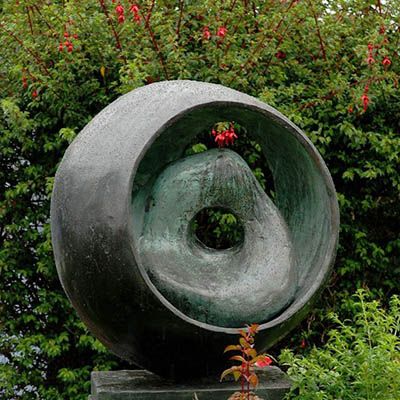
Sphere with Inner Form
In this bronze cast sculpture, a sweeping circular form encases a smaller shape, as if shielding it from harm. The outer casing is smooth and solid, a protective layer to the softer, more organic interior, which still seems to be growing and developing. Themes of protection and growth occupied much of Hepworth's oeuvre, and she observed the universality of this subject, noting how there is "an inside and an outside of every form [...] a nut in its shell or of a child in the womb, or in the structure of shells or of crystals, or when one senses the architecture of bones in the human figure".
Hepworth was settled in St Ives with an established and successful career by the time she made this work. It typifies her interest in flowing, circular forms and their deep connection with the patterns and forms of nature, particularly those in the Cornish landscape, such as sea shells, curling waves, and rock formations. Enclosure was also a recurring subject in Hepworth's art, which she explored in a variety of ways. Critics have often compared these inner and outer forms with a child growing in a mother's womb. Art critic Adrian Stokes noted, "This is the child which the mother owns with all her weight, a child that is of the block yet separate, beyond her womb yet of her being".
The "pierced" hole in the centre of this sculpture was a progressive and innovative approach to sculpture that Hepworth had been exploring since the 1930s; she had opened up the traditional solidity of sculpture to allow air to circulate through the work. Writer Jeanette Winterson spoke of the profound new meanings opened up by these "holes", observing, "The hole is a way back and a way forward. The hole is also the space occupied by the air we are breathing now, by the sunlight that has taken eight minutes to reach us, and by the starlight that is two thousand years old".
Bronze Cast - Barbara Hepworth Museum and Sculpture Garden, Saint Ives, United Kingdom
Wreck
Peter Lanyon - who had taken up hand-gliding and his paintings were often inspired by air movements and the feeling of weightlessness in air - captures the wild turbulence of nature with gestural, aggressive streaks of color. Paint is built up in layers to convey depth, movement, space, and the heightened drama of being exposed to the windswept coastline of his home county of Cornwall. On the left a white, circular form pulls us in like a porthole window, offering a view into the depths of the canvas behind it.
Lanyon made this painting in response to the wreckage of the French trawler named Jeanne Gougy which was dashed onto the jagged rocks at Land's End in 1962. Lanyon had travelled with his family to see the wreck just a few days after the disaster, and was struck by the raw brutality of the ruined boat. His painting captures the harsh and unforgiving nature of the sea with sweeping aqua blue gestures, while a tangle of yellow, red, and flesh tones suggest the forms of the boat in the process of being torn apart.
Lanyon mimed the language of Abstract Expressionism throughout his career and this particular work marked a new departure into daring, bright streaks of color, echoing the work of American Action Painter Willem de Kooning. Like the Abstract Expressionists, Lanyon was more concerned with painting a spiritual response to the world through energised lines, marks and colors, rather than realistic or semi-realistic representations. But, in contrast to the American artists, Lanyon's work was bound up in the unique atmosphere of the Cornish coast and its unique coastal energy. Art historian and curator Toby Treves notes of Lanyon, "He had the ability to express something in a landscape that no one had been able to do before - he managed to evoke a real feeling of being in the place physically and emotionally, with the most wonderful selection of colours - a remarkable feat".
Oil Paint on Canvas - Collection of the Tate, United Kingdom
Beginnings of St Ives School
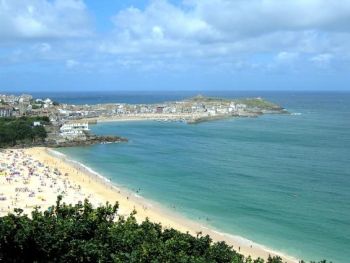
The St Ives School took their name from the coastal town of St Ives, Cornwall, a county on the South Western tip of England. Following the opening of the Great Western railway in 1877 (putting the resort within easy reach of London), St Ives became a place of pilgrimage for many painters who were drawn to the unique quality of its natural light. Artists such as James Abbott McNeill Whistler and Walter Sickert were amongst those who descended on the town in order to paint its sparkling sea views and dramatic jagged coastline. Many painters exhibited their Cornish vistas at the Parisian Salon and London's Royal Academy at the end of the nineteenth century and this exposure did much to open up the area to a wider pool of artists and tourists.
St Ives soon gave rise to a variety of local clubs and societies including the St Ives Club, founded in 1890, and the St Ives Society of Artists, established in 1927. The pioneering pottery artist Bernard Leach founded a studio in St Ives with Japanese artist Shoji Hamada in the 1920s, while painter and teacher Leonard Fuller opened his own private School of Painting in a studio space in the Porthmeor area of St Ives. In 1928, London-based artists Ben Nicholson and Christopher "Kit" Wood made a visit to St Ives, where they encountered by chance the work of local, retired mariner and artist Alfred Wallis. Both artists were inspired by the fresh, naïve and unschooled simplicity of Wallis's coastal scenes, painted as they were onto loose scraps of paper and on found driftwood. Nicholson described his pleasure in discovering Wallis's work thus: "this was an exciting day, for not only was it the first time I saw St. Ives, but on the way back from Porthmeor Beach we passed an open door in Back Road West and through it saw some paintings of ships and houses on odd pieces of paper and cardboard nailed up all over the wall".
Over the following years Nicholson became an avid collector and promoter of Wallis's art, displaying it in his London home and promoting it amongst his circle of friends, including the artist Margaret Mellis and her husband, the art critic Adrian Stokes. The style of Wallis's painting came to influence Nicholson's own practice and that of his friends in London, including Nicholson's first wife, Winifred Nicholson.
St Ives: A World War II Hideout
When the Second World War broke out (in 1939), many artists fled London to escape the bombing. Mellis and Stokes were the first to make the move to St Ives, and they were soon joined by Nicholson and his second wife, the renowned British sculptor Barbara Hepworth, and the Russian Constructivist sculptor Naum Gabo. These metropolitan voices brought with them ideas about avant-garde abstraction which they shared amongst the local artist's community. Both Hepworth and Nicholson had previously made visits to Paris where they took inspiration from the likes of Pablo Picasso, Constantin Brâncuși, Jean Arp, Georges Braque, and Piet Mondrian. Gabo, on the other hand, was a pioneer in Russian Constructivist kinetic sculpture, and he brought these ideas to the St Ives scene.
Movement during wartime was restricted, and art materials scarce, making these years relatively sterile. But by the end of the war in 1945, Nicholson, Hepworth, and Gabo emerged as figureheads for a new generation of artists who had started to combine St Ives's coastal colors, shapes, and forms with the languages of Russian Constructivism, Fauvism, Cubism, and Expressionism. Art critic and curator David Lewis, himself a member of the St Ives community, pointed out how the landscape became the unifying force for creatives working in a wide range of styles: "So the landscape was the common factor for all of us, a presence of perpetual power which in its transitoriness reminds us of our own [...] any pathway we followed, over moors, or down the shafts of mines, or along the corridors of gales, led only to oneself".
The Penwith Society
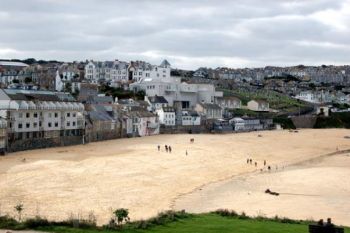
Though artistic styles within the community of St Ives were diverse, an acrimonious split occurred between the more traditional, established locals, who focussed on conventional portrayals of the Cornish landscape, and the newly arrived radicals who favored a progressive modernism. This divide was compounded when the modernists established their own society, called the Crypt Group, which was named after the crypt of a local church where various exhibitions were staged. By 1949 the Crypt Group had evolved into the Penwith Society, with its own large exhibition space at Fore Street in the heart of the town. Hepworth was instrumental in establishing the Porthmeor Studio spaces in an old pilchard factory near Porthmeor beach where many members of the Society worked.
Leading members of the Penwith Society were Hepworth, Nicholson, and Gabo and they were joined by younger artists including Peter Lanyon and Wilhelmina Barns-Graham. Eminent art critic and champion of modern art Herbert Read was appointed group president. This core group of leading modernists created a lively, bustling community and encouraged artists, writers, and curators from further afield to come and visit throughout the 1950s. Some of these offered up funding for events and exhibitions. Notable visitors to the area included British painter Francis Bacon, who borrowed Nicholson's studio for three months, and the American Abstract Expressionist Mark Rothko, who was invited to stay by artist Paul Feiler in 1958.
The St Ives Movement
Throughout the 1950s the face of the St Ives Group began to change. Gabo left Cornwall in 1946, and Nicholson moved on in the late-1950s. Hepworth remained something of a figurehead for the School, but by now a new generation of artists, including Wilhelmina Barns-Graham, Paul Feiler, Terry Frost, Patrick Heron, Roger Hilton, Peter Lanyon, Karl Weschke, John Wells, and Bryan Wynter, were taking hold of the reins. Indeed, it is this "second-wave" group that is most-commonly associated with the name St Ives School.
Although their formal approaches differed, the group were united in a shared appreciation of their unique environment which could be integrated into deconstructed modernist styles. They instigated long-lasting breakthroughs in the development of British and European modernism by taking on the influences of previous and contemporary international styles. For instance, Peter Lanyon's expressive, energised abstractions were directly influenced by the Abstract Expressionist paintings of Willem de Kooning and Mark Rothko, while Heron's crude, geometric colors shared parallels with American artist Sam Francis and Russian-French painter Nicolas de Staël. Barnes-Graham was one of only a few women associated with the group but her elemental, glacial rock faces, drawn with skeletal lines and crude slabs of color, were fixed within the traditions of European abstraction.
Art Historian Charles Harrison argues that the secluded nature of St Ives allowed for radical, experimental approaches that were more difficult to practice in more visible post-war urban cities, providing an obscure oasis where almost anything was possible. He observed, "Under the cultural conditions that prevailed not simply in England but in Europe during the war and its aftermath - an unadulterated modernist culture could only continue in rustication".
An International Focus
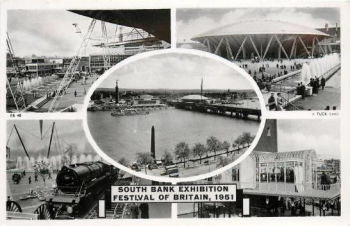
The 1951 Festival of Britain, a huge showcase to promote excellence in British art and design, gave exposure to many of the St Ives School's founding members including Hepworth, Nicholson, Lanyon, and Frost. Hepworth in particular received widespread global recognition throughout these years as she pushed her sculptural innovations to new heights with prominent displays at the Venice Biennale and public art commissions for New York and Japan while continuing to live and work in St Ives.
Dramatic changes in British culture throughout the 1960s undoubtedly influenced the shape of art coming out of St Ives as mass media and rebellious counter cultures gradually took center stage. Driven by the rise in Pop Art across Europe and the United States, artists including William Scott, Peter Lanyon, and Bryan Wynter moved into a cleaner, flatter, and more graphic style. Lanyon incorporated found collage into his art, while Heron abandoned abstraction for figuration. But by the 1960s the dominance of landscape-based ideas practiced by the St Ives School were being eclipsed, while the deaths of several St Ives members including Hepworth, Wynter, and Hilton in the 1970s conclusively signalled the end of an era.
Concepts and Styles
Alfred Wallis and Naïve Art
Alfred Wallis came to art later in life, having spent much of his early years working as a fisherman in the deepest stretches of the ocean. He retired from fishing and settled in St Ives in 1890 while in his mid-30s, setting up a marine rag and bone business selling odds and ends to local fishermen. It wasn't until 1925 that Wallis, then aged 70, came to painting, making rough, expressive studies of the St Ives area in industrial paints including harbour scenes and seascapes with a fluid, simplified language. Much of his work was made on irregular scraps of cardboard, pieces of wood and old jars, lending it a crude, artisanal quality that seemed innately bound to the raggedy landscape of Cornwall.
Wallis's lack of formal training and artistic pretentions made him immensely appealing to the St Ives School who sought ways of emulating the child-like simplicity of his style. Nicholson and Christopher Wood's "discovery" of Wallis's art in the late 1920s led to a surge of interest in the ex-mariner's paintings, as Nicholson and Wood promoted Wallis's paintings amongst the London avant-garde. When the artistic colony of St Ives expanded in the post-war years, there remained an ongoing romance with Wallis's practice. Even so, Wallis was a modest man who never fully connected with the modernists of St Ives and referred to them in fact as the "real painters" of St Ives.
Of all the St Ives artists, Nicholson was perhaps the most profoundly moved by the untutored freedom in Wallis's landscapes. Prior to discovering Wallis's art he had moved away from pure abstraction towards naturalism, but Nicholson had been searching for a way to express reality with a fresh, modernist language. Taking inspiration from Wallis's simplified style, he began painting with flattened shapes, slanted angles, and uneven textures from the late 1920s until the 1940s, as seen in the painting such as 1943-45 (St Ives, Cornwall) (1943-5).
Though she never moved to St Ives, Nicholson's first wife, Winifred Nicholson, painted throughout the 1930s with a naïve style also influenced by Wallis. The crude, expressive energy of Wallis's art also had a profound impact on Margaret Mellis's paintings and constructions, and, like Wallis, she often painted her subjects onto scraps of torn paper and carboard, echoing his unpretentious approach. But it was also the way Wallis's art seemed innately bound to place that left the most indelible imprint on Nicholson and his contemporaries. Nicholson observed with fascination how Wallis's art seemed like "something that has grown out of the Cornish seas and earth and which will endure".
The Cornish Landscape
The Cornish landscape, with its wild, rugged, naturalism, was undoubtedly one of the key uniting forces of the artists who congregated in St Ives. Nicholson and Barnes Graham both worked gradually towards a refined, spatial abstraction that emulated the soft, sandy hues and sparkling aqua blues of the Cornish coast, suggesting craggy outlines of rocks with crisp shards of line. Margaret Mellis, on the other hand, was an avid collector of driftwood, collecting scraps of worn-down driftwood from old fishing boats and arranging them into loose, haphazard arrangements where colors and textures jostle against one another. Patrick Heron was also profoundly moved by Cornish light and colors, observed from his clifftop studio that looked out across the sea and moors beyond: "This is a landscape that has altered my life, the house in its setting is the source of all my painting", he said. He captured the wild tangles of colour and energy around him with flat pattern and vivid, heightened colour, as seen in such works as Harbour Window with Two Figures: St Ives, (1950).
Modernist Sculpture: Hepworth and Gabo
Both Hepworth and Gabo made a series of important advances in sculpture while resident in St Ives. Hepworth was, by the 1940s, already an established artist with a reputation for making organic, sinuous sculptures through the intuitive, improvised process of "direct carving" which allowed the work to evolve naturally in response to the materials. The landscape of Cornwall chimed well with her interest in naturalism and she began making abstract sculptures inspired by her natural surroundings. Much of her work was a deeply personal, intuitive response to her encounters with nature, but it also tapped into formal concerns about interior and exterior space and the pure spirituality of form. Sweeping curves and ovals in works such as Pelagos (1946), and Curved Form (Trevalgan) (1956), collapse references to shells, waves, caves and curved coastlines into a minimalist whole, while inner, taut passages of string explore what Hepworth called "the tension I felt between myself and the sea, the wind or the hills".
For his part, the Russian émigré Gabo was a highly respected member of the Russian Constructivist movement before his relocation to England. When in St Ives he was able to continue developing his avant-garde ideas around kinetics, construction, and the spatial interplay of forms. Here Gabo pioneered the use of plastic in sculpture, producing minimalist pieces from a series of clear panels. Conflicting inner and outer elements was paramount to his practice, as exemplified in Construction in Space with Crystalline Centre (1938-40), where the inner core seems suspended "mid-action" and in mid-air. Gabo's practice bore little resemblance to the Cornish landscape, however, and was concerned rather with concepts of movement, tension, and space.
Pure Abstraction
The provincial setting of St Ives allowed artists who moved there to freely indulge their passion for formal experimentation. Their work offered a counterpoint to the gritty, urban concerns of post-war modernism; what art historian Charles Harrison identified as "patriotism, nationalism, xenophobia, insularity and angst which was [being] expressed in Graham Sutherland's work and then in Francis Bacon's". Indeed, much of the art made in St Ives during the 1940s and 1950s took the form of two- and three-dimensional abstractions.
Before the outbreak of World War Two, Nicholson and Hepworth had spent time mingling with the avant-garde elite of Europe and had witnessed first-hand the evolution of geometricized movements, notably Cubism and De Stijl. The De Stijl notion of spiritual purity and utopianism were particularly influential on both artists, and Piet Mondrian's spirit rippled throughout Nicholson's low-relief painterly constructions, and Hepworth's circular forms and holes. Patrick Heron, who proclaimed that all art could be considered abstract, explored Cubist principles through interlaced patterns of color that captured the sensations of light and space in two dimensions.
The emergence of Abstract Expressionism displaced De Stijl and Cubism as the bigger influence on the St Ives School. Roger Hilton, who had initially followed the lead of Mondrian by painting in controlled whites, reds, and blacks, had, by the mid-1950s, begun to absorb the influence of Abstract Expressionism through his shift towards energetic gestural brushwork. Peter Lanyon's Cubist inspired paintings, which were made as part of a series of "experiential landscapes" combining multiple views within a single canvas, gave way to broad, sweeping strokes of heightened color which captured the spiritual essence and natural phenomena of the Cornish coastline. The German Paul Feiler also revealed the influence of Abstract Expressionism, and especially that of his friend, Mark Rothko through his "block" paintings of the 1950s. Feiler transformed the south west coastline through narrow bands of colour and square and circular shapes, while Bryan Wynter, who was fascinated with abstract, elemental forces, spiritualism, and the natural environment, expressed himself through lively, sweeping strokes of animated color.
Later Developments - After St Ives School
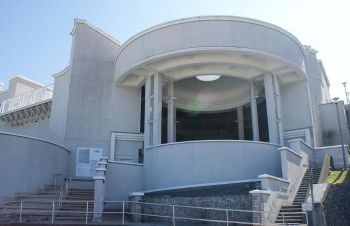
The Tate Gallery played a vital role in preserving the legacy of the St Ives School. Following Barbara Hepworth's tragic death by fire in her Trewyn studio in 1975, Tate Gallery restored the former site into the Barbara Hepworth Museum and Sculpture Garden which opened to the public in 1980. London Tate's survey exhibition St Ives: Twenty-Five Years of Painting, Sculpture and Pottery in 1985, did much to renew interest in the School and, in 1988, a building was chosen on the site of a former gasworks overlooking Porthmeor Beach and the Atlantic Ocean for Tate St Ives. Funded by donations from the local community, the Henry Moore Foundation and the European Regional Development Fund, Tate Gallery, St Ives opened in 1993. Such was its success (with an estimated quarter-of-a-million visitors per annum) a refurbish and extend (doubling the exhibition space) Tate St Ives opened in 2017.
Although he distanced himself from the modernist group, Alfred Wallis has proved an enduring influence on future generations. Andrew Lanyon (son of Peter) works across various media including photography, painting and film, paying tribute to the unique atmosphere of St Ives and the rich historical significance of the place in British cultural history. Los Angeles painter Danny Fox, who was born in St Ives, cites the simplified, flattened designs, crude materials and bold colors of Wallis's art as the primary influence on his illustrative paintings and wooden constructions.
The pioneering British style of modernism that continued in St Ives throughout the post-war period has influenced a number of artists since. These include British painter Tomma Abts, whose muted colors and low-relief illusionism bears a close resemblance to Nicholson's abstraction. The semi-figurative, geometric abstraction of artists such as Lanyon and Heron have been taken up in recent years by British artist Tony Swain, who combines newspaper excerpts with painterly passages of paint. The British painter Dexter Dalwood, also merges a language of collage with paint.
Meanwhile, The South-Korean artist Haegue Yang works with a range of found materials to create immersive, site-specific installations that hover between realism and abstraction. She recently produced a body of work inspired by the St Ives coastline for display at Tate St Ives, observing of the natural landscape in Cornwall, "I felt so exposed to nature and the local cultural and sacred landscapes. Sentimental, melancholic, even romantic feelings overwhelmed me - tough and rough, sometimes dangerous, as well as mystical".
Useful Resources on St Ives School
- Ben Nicholson (St Ives Artists series)By Virginia Button
- Ben NicholsonBy Norbert Lynton
- Barbara Hepworth (St Ives Artists series)By Penelope Curtis
- Bernard Leach, Barbara Hepworth in Recognition of Their International Contribution to the Arts by Borough of St. Ives CornwallBy Borough of St. Ives Cornwall
- Naum Gabo: Constructions, Paintings, DrawingsBy Herbert Read
- Peter LanyonBy Chris Stephens
- W. Barns-Graham: a Scottish Artist in St. IvesBy Lynne Green
- Movement and Light: Imagining TimeBy Wilhelmina-Barns Graham; Mel Gooding; Susan Daniel-McElroy
- Bryan WynterBy Chris Stephens
- St. Ives Artists: Patrick HeronBy Michael McNay
- Margaret MellisBy Andrew Lambirth
- Alfred Wallis: Artist and MarinerBy Robert Jones
- Alfred Wallis (British Artists Series)By Matthew Gale
- Terry Frost (Tate British Artist Series): British artists seriesBy Chris Stephens
- Terry Frost (St Ives Artists series)By Chris Stephens
- St Ives: The art and the artistsBy Chris Stephens
- The St Ives ArtistsBy Michael Bird
- St Ives, 1893-1993: Portrait of an Art ColonyBy Marion Whybrow
- Painting the Warmth of the Sun, St Ives Artists 1939-1975By Tom Cross
- The Alfred Wallis Factor: Conflict in Post-War St Ives ArtBy David Wilkinson
- St Ives Artists: A CompanionBy Virginia Button
- Modern Art and St IvesBy Chris Stephens
- St. Ives, 1939-64: Twenty-Five Years of Painting, Sculpture and PotteryBy David Brown
- St Ives and British ModernismBy Jonathan Clark
- Selections from St Ives: W. Barns-Graham, Terry Frost, Barbara Hepworth, Patrick Heron, Roger Hilton, Peter Lanyon, Denis Mitchell, Ben Nicholson, John Wells, Bryan WynterBy David Lewis
 Ask The Art Story AI
Ask The Art Story AI















